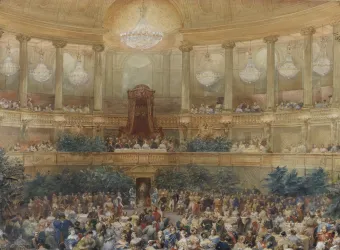Having become a central storage depot for the arts for the Department of Seine-et-Oise in 1792, the Palace later saw the creation of a Central Museum for the arts. It was later replaced by the Special Museum of the French School, to complement the Louvre, which was to focus on foreign schools of art.

Creation of the Special Museum of the French School, 1797 28 January 1797
The Commission of the Arts of Seine-et-Oise was created on 19 October 1792, and mandated to collect for the nation all items of art and science from national properties in the region (former royal residences, religious buildings, private manor houses, etc.). It used the Palace as a central depository while plans to create a museum out of the former royal residence of the Louvre were drafted. The Louvre was opened as the national museum in 1793.
ANECDOTE
On 18 April 1796 the Central Museum of the Arts of Versailles was officially opened to the public for two days out of every ten.
For the town of Versailles, preserving the museum was a matter of survival. Saddened to see the art works that had made the Palace great taken down off the walls and carted off to the Louvre, the local residents drafted petition after petition calling upon the Convention to create a second museum. The Louvre should not be the sole destination for the Republic’s masterpieces, they asserted. The rivalry between Paris and Versailles, followed by reconciliation, made both the fortune and misfortune of the first Versailles museum.
The project began in May 1794 when the Convention decided to preserve the Palace for the enjoyment of the people, and in 1795 the first Curator was elected: Hugues Lagarde. Over three months he laid down the different sections of the future museum. A library would go into the south wing, with a Prints and Engravings section, like in the Louvre, while a scientific section would occupy the north wing. Lagarde had paintings hung in the State Apartments and had the statues in the Park and at Marly brought inside to protect them from the vandalism of the revolutionaries. On 18 April 1796 the Central Museum of the Arts of Versailles was officially opened to the public, for two days out of every ten.
In 1797, however, everything changed yet again. In January the Directorate decided to make the Louvre a museum of foreign schools, and Versailles a museum of the French school. A complicated exchange of works was organised, and masterpieces by the likes of Poussin, Champaigne and Lesueur were displayed in the State Apartments, alongside statues. Although the museum was opened in 1801, it was slowly but surely emptied of works, transferred to other institutions and imperial residences, and it was finally and firmly closed in 1810. At this time Napoleon began taking an interest in the Palace and carried out major restoration work. The idea of a museum was forgotten once again, until 1833.











